Hormone Replacement Therapy (HRT) is a highly effective way to address the symptoms associated with hormonal imbalances, such as fatigue, mood swings, weight gain, and reduced libido. For many, HRT can dramatically improve quality of life by restoring hormone levels to their optimal state. However, choosing the right method of HRT is crucial to ensuring the best outcomes. Understanding the differences between injectable and pellet HRT can help you make an informed decision about which option is best suited to your needs
What Is Hormone Replacement Therapy?
Hormone Replacement Therapy involves supplementing the body with hormones that are no longer being produced in sufficient quantities due to aging, menopause, andropause, or other medical conditions. This therapy is used to treat a wide range of symptoms, including fatigue, hot flashes, mood swings, weight gain, muscle loss, and sexual dysfunction. By restoring hormone levels, HRT helps to rebalance the body and alleviate these symptoms, leading to improved well-being.
Understanding Injectable HRT
Injectable HRT involves administering hormones directly into the bloodstream through an injection. The most common hormones delivered via injection include testosterone, estrogen, and sometimes progesterone. These injections are usually given every one to two weeks, depending on the specific hormone and the individual’s treatment plan.
Benefits of Injectable HRT
- Precise Dosing: One of the key advantages of injectable HRT is the ability to precisely control hormone levels. Because the dosage can be adjusted with each injection, it allows for a highly tailored approach to treatment. This precision is particularly important for individuals whose hormone levels fluctuate or who require specific adjustments to their therapy.
- Rapid Symptom Relief: Hormones delivered via injection are quickly absorbed into the bloodstream, leading to rapid relief from symptoms. For many individuals, the effects of the injection can be felt within 24 to 48 hours, making this a desirable option for those seeking quick results.
- Flexibility in Adjustments: Injectable HRT provides flexibility in adjusting hormone levels. If you experience side effects or need a dosage change, your healthcare provider can easily modify the amount or frequency of the injections to better suit your needs. This adaptability is crucial for fine-tuning your treatment.
- Less Invasive: While injections do involve needles, they are generally considered less invasive than surgical options like pellet insertion. For individuals who prefer to avoid surgical procedures, injectable HRT offers a non-surgical alternative that is easy to manage.
Considerations for Injectable HRT
- Frequency of Injections: Injectable HRT requires regular appointments for injections, typically every one to two weeks. For some, this frequent schedule may be inconvenient, particularly if you have a busy lifestyle or prefer not to visit a clinic regularly. However, many individuals become comfortable with self-administering injections at home, which can alleviate the need for frequent clinic visits.
- Hormone Fluctuations: Since injections are spaced out over several days, hormone levels can fluctuate between doses. Some individuals may experience peaks and troughs in their hormone levels, leading to variable symptom control. For example, you might feel a surge of energy shortly after an injection, followed by a gradual decrease as the hormone levels decline before the next dose.
- Self-Injection: While some patients are comfortable self-administering injections at home, others may find the process daunting or uncomfortable. Proper training and confidence in administering injections are essential if you opt for this route.
Understanding Pellet HRT
Pellet HRT involves the insertion of small, rice-sized hormone pellets just under the skin, usually in the hip or buttock area. These pellets slowly release hormones into the bloodstream over several months, providing a steady and consistent dose of hormones.
Benefits of Pellet HRT
- Steady Hormone Release: A significant advantage of pellet HRT is the consistent release of hormones over time. This steady release helps to maintain stable hormone levels without the fluctuations associated with injectable HRT. As a result, many individuals experience a more balanced mood, sustained energy levels, and better overall symptom control.
- Convenience and Compliance: Once the pellets are inserted, they continuously deliver hormones for three to six months, depending on the individual and the hormone used. This long-lasting effect means fewer visits to the clinic and less time spent managing your therapy. For those with busy schedules or who prefer a “set it and forget it” approach, pellet HRT offers significant convenience.
- Reduced Frequency of Treatment: Pellet HRT reduces the need for frequent interventions, as the hormone levels remain consistent for an extended period. This can improve compliance, as there’s no need to remember daily pills or weekly injections.
- Less Maintenance: Unlike injectable HRT, which requires ongoing appointments or self-administration, pellet HRT involves a single procedure followed by several months of consistent hormone delivery. This minimal maintenance is ideal for those who prefer not to think about their hormone therapy regularly.
Considerations for Pellet HRT
- Invasive Procedure: Pellet insertion is a minor surgical procedure that requires a small incision to place the pellets under the skin. While the procedure is quick and typically performed under local anesthesia, it may not be suitable for everyone. Some individuals may prefer to avoid even minor surgical procedures due to concerns about discomfort, healing time, or scarring.
- Less Flexibility: Once the pellets are inserted, adjusting hormone levels is more challenging than with injectable HRT. If you experience side effects or need a dosage change, you may have to wait for the pellets to dissolve or be removed, which can be inconvenient. This lack of flexibility can be a drawback for those who require frequent adjustments to their hormone levels.
- Upfront Cost: While pellet HRT may offer long-term convenience, the initial cost is often higher than other forms of HRT due to the procedure involved in inserting the pellets. It’s important to consider whether this upfront investment fits within your budget and if the convenience justifies the cost.
- Potential for Complications: Although rare, there is a risk of complications with pellet insertion, such as infection at the insertion site, pellet extrusion, or uneven absorption. These risks should be discussed with your healthcare provider before deciding on pellet HRT.
Factors to Consider When Choosing Between Injectable and Pellet HRT
When deciding between injectable and pellet HRT, several factors should be taken into account to ensure you choose the option that best aligns with your needs and lifestyle:
- Lifestyle and Convenience: Consider how each method fits into your daily routine. If you prefer a treatment that requires minimal maintenance and fewer clinic visits, pellet HRT might be the better option. On the other hand, if you value the ability to make quick adjustments to your hormone levels and don’t mind more frequent appointments, injectable HRT may be more suitable.
- Consistency of Hormone Levels: If you’re sensitive to hormone fluctuations and prefer a consistent, steady release of hormones, pellet HRT may provide the stability you need. However, if you are comfortable with occasional fluctuations and appreciate the ability to tailor your treatment more frequently, injectable HRT offers greater control.
- Cost and Budget: Evaluate the cost of each treatment method. Injectable HRT typically involves lower upfront costs but requires ongoing expenses for regular injections. Pellet HRT has a higher initial cost due to the insertion procedure but offers long-term convenience with fewer follow-up costs. Consider your budget and the value you place on convenience versus flexibility.
- Health and Medical History: Your overall health, medical history, and specific hormone needs should play a crucial role in your decision. For example, individuals with certain medical conditions may be better suited to one method over the other. Discuss your options with your healthcare provider to determine which form of HRT is safest and most effective for you.
- Personal Preferences: Ultimately, your personal preferences and comfort level with each method should guide your decision. Some individuals prefer the control and flexibility of injectable HRT, while others value the convenience and consistency of pellet HRT. Consider which aspects of treatment are most important to you and how each method aligns with your lifestyle.
Making the Right Choice for Your Hormone Replacement Therapy
Both injectable and pellet HRT offer unique benefits and can effectively restore hormone balance, helping you feel more energized, balanced, and healthy. The right choice for you will depend on your personal preferences, lifestyle, and how your body responds to treatment. At Reverse Aesthetics, we’re here to guide you through the decision-making process, offering personalized consultations to help you choose the best HRT method for your needs. Whether you opt for injectable or pellet HRT, our goal is to help you achieve optimal well-being and enjoy a revitalized quality of life.
If you’re ready to explore Hormone Replacement Therapy, contact us today to schedule your consultation and take the first step toward feeling your best.











